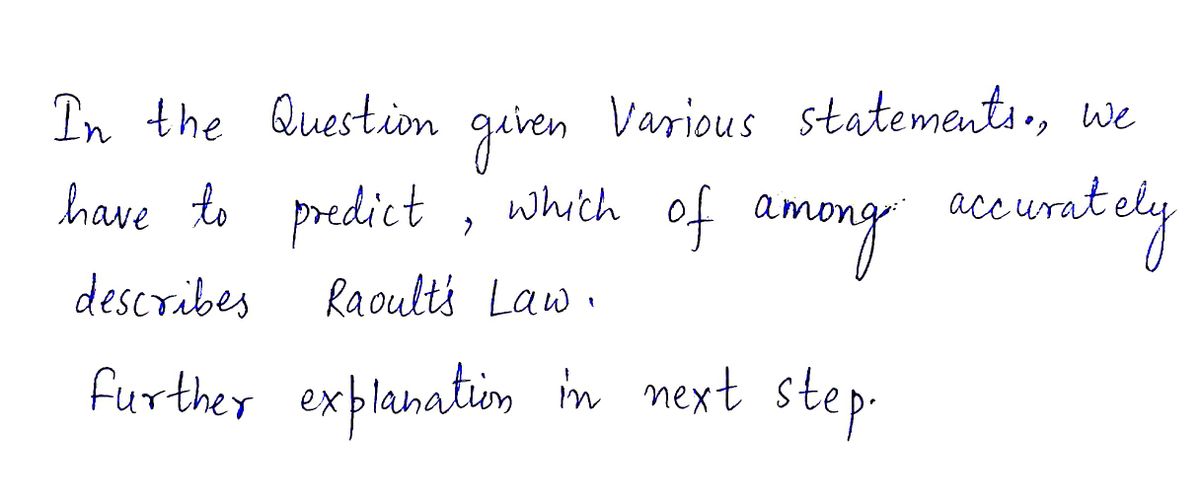Which of the following accurately describes Raoult's Law? O The vapor pressure of such a solution is greater than how much of the solution actually consists of the solvent. O The vapor pressure of such a solution is proportional to how much of the solution actually consists of the solvent. O The vapor pressure of such a solution is less than how much of the solution actually consists of the solvent. O The vapor pressure of the solution, Psolution, equals the mole fraction of the solvent, Xsolvent, multiplied by its vapor pressure when pure, P°solvent- O The vapor pressure of the solution, Psolution, equals the molality of the solvent, msolvent, divided by its vapor pressure when pure, P°solvent- Msolvent P solvent po solvent O Psolution Xsolvent Po solvent
Which of the following accurately describes Raoult's Law? O The vapor pressure of such a solution is greater than how much of the solution actually consists of the solvent. O The vapor pressure of such a solution is proportional to how much of the solution actually consists of the solvent. O The vapor pressure of such a solution is less than how much of the solution actually consists of the solvent. O The vapor pressure of the solution, Psolution, equals the mole fraction of the solvent, Xsolvent, multiplied by its vapor pressure when pure, P°solvent- O The vapor pressure of the solution, Psolution, equals the molality of the solvent, msolvent, divided by its vapor pressure when pure, P°solvent- Msolvent P solvent po solvent O Psolution Xsolvent Po solvent
Chemistry
10th Edition
ISBN:9781305957404
Author:Steven S. Zumdahl, Susan A. Zumdahl, Donald J. DeCoste
Publisher:Steven S. Zumdahl, Susan A. Zumdahl, Donald J. DeCoste
Chapter1: Chemical Foundations
Section: Chapter Questions
Problem 1RQ: Define and explain the differences between the following terms. a. law and theory b. theory and...
Related questions
Question

Transcribed Image Text:Which of the following accurately describes Raoult's Law?
O The vapor pressure of such a solution is greater than how much of the solution actually consists of the solvent.
O The vapor pressure of such a solution is proportional to how much of the solution actually consists of the solvent.
O The vapor pressure of such a solution is less than how much of the solution actually consists of the solvent.
O The vapor pressure of the solution, Psolution, equals the mole fraction of the solvent, Xsolvent, multiplied by its vapor
pressure when pure, P°solvent-
O The vapor pressure of the solution, Psolution, equals the molality of the solvent, msolvent, divided by its vapor pressure
when pure, P°solvent-
Msolvent
P
solvent
P° solvent
O Psolution
Xsolvent Po
solvent
Attempts: 1 of 15 used
Submit Answer
Save for Later
МacBook Air
Expert Solution
Step 1

Trending now
This is a popular solution!
Step by step
Solved in 2 steps with 2 images

Knowledge Booster
Learn more about
Need a deep-dive on the concept behind this application? Look no further. Learn more about this topic, chemistry and related others by exploring similar questions and additional content below.Recommended textbooks for you

Chemistry
Chemistry
ISBN:
9781305957404
Author:
Steven S. Zumdahl, Susan A. Zumdahl, Donald J. DeCoste
Publisher:
Cengage Learning

Chemistry
Chemistry
ISBN:
9781259911156
Author:
Raymond Chang Dr., Jason Overby Professor
Publisher:
McGraw-Hill Education

Principles of Instrumental Analysis
Chemistry
ISBN:
9781305577213
Author:
Douglas A. Skoog, F. James Holler, Stanley R. Crouch
Publisher:
Cengage Learning

Chemistry
Chemistry
ISBN:
9781305957404
Author:
Steven S. Zumdahl, Susan A. Zumdahl, Donald J. DeCoste
Publisher:
Cengage Learning

Chemistry
Chemistry
ISBN:
9781259911156
Author:
Raymond Chang Dr., Jason Overby Professor
Publisher:
McGraw-Hill Education

Principles of Instrumental Analysis
Chemistry
ISBN:
9781305577213
Author:
Douglas A. Skoog, F. James Holler, Stanley R. Crouch
Publisher:
Cengage Learning

Organic Chemistry
Chemistry
ISBN:
9780078021558
Author:
Janice Gorzynski Smith Dr.
Publisher:
McGraw-Hill Education

Chemistry: Principles and Reactions
Chemistry
ISBN:
9781305079373
Author:
William L. Masterton, Cecile N. Hurley
Publisher:
Cengage Learning

Elementary Principles of Chemical Processes, Bind…
Chemistry
ISBN:
9781118431221
Author:
Richard M. Felder, Ronald W. Rousseau, Lisa G. Bullard
Publisher:
WILEY